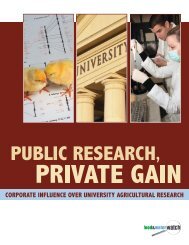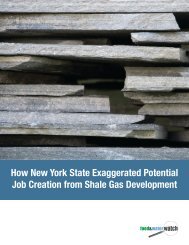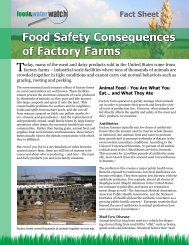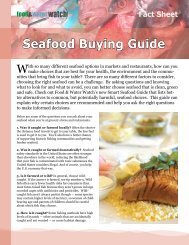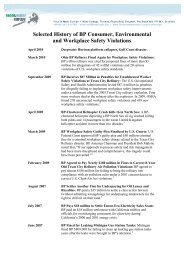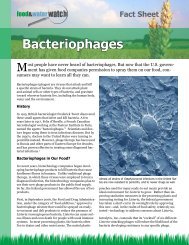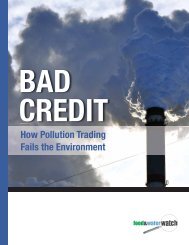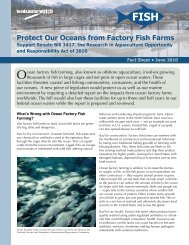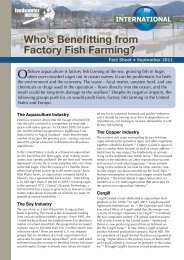Farming Oysters, Clams and Mussels - Food & Water Watch
Farming Oysters, Clams and Mussels - Food & Water Watch
Farming Oysters, Clams and Mussels - Food & Water Watch
You also want an ePaper? Increase the reach of your titles
YUMPU automatically turns print PDFs into web optimized ePapers that Google loves.
<strong>Farming</strong> <strong>Oysters</strong>, <strong>Clams</strong> <strong>and</strong><br />
<strong>Mussels</strong><br />
The U.S. government is currently exploring ways to boost<br />
seafood production through aquaculture (i.e., fish farming).<br />
Certain types of fish farms have been associated with<br />
serious environmental, economic <strong>and</strong> cultural concerns,<br />
including industrial-size finfish facilities in the ocean <strong>and</strong><br />
international coastal shrimp operations. But some methods<br />
of shellfish farming could provide an alternate means<br />
to help supplement our seafood supply. Carefully located,<br />
well-designed oyster, mussel <strong>and</strong> clam farms could help<br />
achieve the goal of exp<strong>and</strong>ing U.S. seafood production,<br />
while also providing food for health-conscious, environmentally<br />
concerned consumers.<br />
Benefits of shellfish farming<br />
<strong>Oysters</strong>, clams <strong>and</strong> mussels are collectively called “mollusks”<br />
or “bivalves” (meaning two “doors,” i.e., shells). They<br />
eat by filtering microscopic algae <strong>and</strong> other small particles<br />
from the water. No added food is necessary to grow these<br />
shellfish. Some other types of fish farms use feeds made<br />
from small, wild fish, leaving less food for marine wildlife<br />
<strong>and</strong> coastal communities worldwide that depend on small<br />
fish for protein. It can take several pounds of wild fish to<br />
grow just one pound of farmed finfish, which means we<br />
are using up more fish than we get from farming. This is an<br />
inefficient use of important resources, <strong>and</strong> farming mussels,<br />
oysters <strong>and</strong> clams can avoid this overuse of wild fish.<br />
Issue Brief • December 2010<br />
Carefully located, welldesigned<br />
oyster, mussel <strong>and</strong><br />
clam farms could help achieve<br />
the goal of exp<strong>and</strong>ing U.S.<br />
seafood production, while<br />
also providing food for healthconscious,<br />
environmentally<br />
concerned consumers.<br />
www.food<strong>and</strong>waterwatch.org • 1616 P St. NW, Washington, DC 20036 • info@fwwatch.org
Bivalve farms do not pollute the surrounding waters with<br />
wasted feed, <strong>and</strong> in some cases, they may even improve<br />
local water quality since they filter the water as they feed.<br />
This is a valuable ecosystem service in coastal waters,<br />
most of which are overloaded with nitrogen <strong>and</strong> various<br />
other nutrients from l<strong>and</strong>-based practices like agriculture.<br />
1 In fact, reductions in wild populations of filter-feeding<br />
shellfish have likely contributed to declines in water<br />
quality in some coastal areas. 2 <strong>Clams</strong>, for instance, can<br />
help clean waters by filtering up to two gallons of water<br />
per hour. 3<br />
Additionally, mussel, oyster <strong>and</strong> clam farms very rarely<br />
use pesticides, fertilizers, antibiotics or other chemicals in<br />
their operations. 4<br />
Background<br />
According to the 2005 aquaculture census, $203 million<br />
worth of oysters, mussels <strong>and</strong> clams were produced in the<br />
United States that year. 5<br />
increasing dem<strong>and</strong> for the sweet, tender Manila clams led<br />
to a rapidly exp<strong>and</strong>ing industry for their cultivation on the<br />
West Coast. 10 In the United States, these farms are heavily<br />
concentrated in Washington State. 11 Manila clams are<br />
typically served steamed. 12<br />
<strong>Mussels</strong><br />
Several types of mussels are cultivated for food, the most<br />
common of which in North America is the blue mussel<br />
(Mytilus edulis). Mussel farming dates back to at least the<br />
13 th century 13 <strong>and</strong> is common in Europe, where mussels<br />
remain very popular. Despite historically lower dem<strong>and</strong><br />
in the United States, mussels have been steadily gaining<br />
recognition as a delicious, healthy, sustainable seafood.<br />
The majority of mussels eaten in the United States are<br />
currently imported from farms in Canada or New Zeal<strong>and</strong>.<br />
Mussel farms within the United States are located primarily<br />
in New Engl<strong>and</strong> or Washington State, with smaller<br />
numbers of farms in California <strong>and</strong> Alaska. 14<br />
<strong>Oysters</strong><br />
<strong>Oysters</strong> are the most widely cultivated of the three mollusks<br />
in the United States. About 70 percent of oysters<br />
grown in the United States are American cupped oysters<br />
(Crassostrea virginica), mostly farmed in the Atlantic (especially<br />
Massachusetts) <strong>and</strong> the Gulf of Mexico (especially<br />
Louisiana). 6 Most of the remaining production comes<br />
from the Pacific cupped oyster (Crassostrea gigas), native<br />
to Japan, but grown along the Pacific coast from California<br />
to Alaska, predominantly in Washington. 7 U.S. farms also<br />
raise small quantities of several types of specialty oysters.<br />
<strong>Oysters</strong> are popular raw “on the half shell” (served sitting<br />
in one side of the shell) at seafood bars, as well as<br />
steamed, roasted <strong>and</strong> fried.<br />
<strong>Clams</strong><br />
There are many edible species of clams, but the majority<br />
of those consumed in the United States are either<br />
hard clams (Mercenaria mercenaria) or Manila clams<br />
(Ruditapes philppinarum). Hard clams are native to the<br />
East Coast of the United States. The industry has been<br />
especially successful in Virginia <strong>and</strong> Florida, followed by<br />
Connecticut, Massachusetts <strong>and</strong> New Jersey in production.<br />
8 Hard clams are sold under different names depending<br />
on their size. The smallest (<strong>and</strong> most valued) are the<br />
“littlenecks”; slightly larger are the “topnecks” <strong>and</strong> “cherrystones.”<br />
<strong>Clams</strong> larger than these are usually called “quahogs”<br />
(pronounced co-hogs) or “chowder clams.” 9 Manila<br />
clams are native to Asia, but were accidentally introduced<br />
to North America in the early 1900s with imported “seed”<br />
(i.e., young clams) from Japan. Starting in the 1980s,
Why Oyster, Clam <strong>and</strong> Mussel <strong>Farming</strong> Is a Good Alternative for…<br />
Fish Farmers Consumers The Planet<br />
• Because chemicals <strong>and</strong> feed are<br />
not needed, there are low input<br />
costs<br />
• <strong>Mussels</strong> can be grown at high densities<br />
<strong>and</strong> large-scale mortalities<br />
from disease are rare<br />
• There is less resistance from environmentalists<br />
<strong>and</strong> concerned consumers<br />
than with finfish farming<br />
• More sustainable methods can<br />
also be better for production <strong>and</strong><br />
quality (e.g. oyster floats <strong>and</strong> ropegrown<br />
mussels)<br />
• These shellfish are low in calories<br />
<strong>and</strong> high in protein<br />
• They contain high levels of<br />
omega-3 fatty acids, vitamin C<br />
<strong>and</strong> iron<br />
• Consumers can feel good about<br />
making a sustainable choice<br />
• Compared to imported seafood,<br />
U.S.-grown oyster, clams<br />
<strong>and</strong> mussels will be carefully<br />
monitored for contamination <strong>and</strong><br />
safety<br />
• These “filter feeders” can improve<br />
water quality by removing<br />
pollutants<br />
• They require no added feed,<br />
meaning small, wild fish aren’t<br />
depleted to make aquaculture<br />
feed <strong>and</strong> there is no pollution<br />
from uneaten feed<br />
• Bivalve shellfish farmers rarely<br />
use chemicals in their operations<br />
• Native or established species<br />
can be used, so wild populations<br />
are not threatened<br />
Production Methods<br />
<strong>Oysters</strong><br />
Most farmed oysters are produced in a controlled hatchery<br />
environment. After they enter a growth stage known as<br />
a spat when they reach about the size of a pea, they are<br />
typically transplanted to open-water (non-hatchery) locations<br />
to grow to full size. 15 <strong>Oysters</strong> can be grown either on<br />
or off the bottom of the seafloor. In traditional ocean-bed<br />
culture, hatchery-grown spat are placed on pieces of dried<br />
shell called cultch, 16 which are placed on the seafloor<br />
near shore <strong>and</strong> covered with mesh to protect them from<br />
natural ocean predators. They can also be grown in intertidal<br />
areas, the region near the shoreline between the<br />
low-water <strong>and</strong> the high-water marks. There, oysters are<br />
exposed to the air during low tides, which helps make<br />
collection easier <strong>and</strong> protects against predators <strong>and</strong> the<br />
growth of fouling organisms. Raising oysters too close to<br />
the sea bottom can create problems, however. The current<br />
is not strong in these areas, so waste may accumulate <strong>and</strong><br />
sediment may interfere with feeding. 17 Collecting bottomcultured<br />
oysters can also disrupt <strong>and</strong> damage the natural<br />
habitat, especially if done regularly.<br />
Alternately, cultch (with spat) can be placed inside burlap<br />
mesh bags on trestled racks that are set up like shelves<br />
several feet above the ocean floor. 18 This “rack” or “bag<br />
culture” method can be slightly more expensive <strong>and</strong> requires<br />
maintenance to ensure oysters are getting enough<br />
oxygen, 19 but it makes for easier <strong>and</strong> more ecologically<br />
friendly collection. Additionally, off-bottom techniques<br />
are being developed in Maryl<strong>and</strong> on the Chesapeake<br />
Bay involving floatation devices made from PVC frames<br />
on which these racks or bags can be placed. This can<br />
mitigate potential negative impacts to the seafloor, <strong>and</strong><br />
is also thought to cause faster growth. However, growers<br />
must be vigilant about water quality, as the oysters are<br />
generally raised closer to l<strong>and</strong> where water may be more<br />
contaminated. 20<br />
<strong>Clams</strong><br />
Clam aquaculture typically occurs in three stages: hatchery,<br />
nursery <strong>and</strong> grow-out. Because it is generally difficult<br />
to collect juvenile clams from the wild, clam farming on<br />
a commercial scale requires hatcheries to produce seed. 21<br />
Hatcheries use adult clams to produce larvae, which<br />
remain in the hatchery until they reach about 1 millimeter<br />
in size. 22 Next, clams are protected from predators in<br />
a nursery until they reach about 8 to 10 millimeters in<br />
size, which takes several months. 23 . 24 Nurseries can be<br />
either l<strong>and</strong>-based, in locations with access to seawater, or<br />
field-based, in shallow coastal waters using some method<br />
of predator control, like netting. For both field- <strong>and</strong> l<strong>and</strong>based<br />
systems, circulating seawater provides the clams<br />
with naturally occurring plankton<br />
Finally, clams are usually grown to market size on shallow-water<br />
coastal plots leased from the state. <strong>Clams</strong> are<br />
placed on the bottom <strong>and</strong> covered with protective netting<br />
or held in soft-meshed polyester bags. Once the clams<br />
reach market size, they can be collected by h<strong>and</strong>-raking,<br />
or in the case of “bag culture” (similar to the method<br />
used for oysters, above), the bags can simply be lifted out<br />
of the water. 25
Although relatively few diseases have been reported in<br />
hard clams, there is one hard clam pathogen that has<br />
caused problems for clam farmers north of Virginia,<br />
known as QPX for “Quahog pathogen unknown.” 26 This<br />
parasite is not harmful to humans, but does cause large<br />
die-offs of infected clams. QPX is thought to infect adult<br />
clams experiencing stressful growing conditions in highsalinity<br />
environments. 27 The development of testing methods<br />
for QPX has reduced the risk of spreading the disease,<br />
but clams should be grown at reasonable densities using<br />
local seed to minimize risks. 28<br />
<strong>Mussels</strong><br />
<strong>Mussels</strong> are farmed in two basic ways: suspended culture<br />
or bottom culture. Bottom culture usually involves collecting<br />
native, wild juvenile mussels, called “spat” or “seed,”<br />
often through dredging, <strong>and</strong> re-laying them over sites on<br />
the sea bottom, at lower densities. 29 This method yields<br />
mussels with less meat <strong>and</strong> also increases the amount of<br />
grit, 30 which needs to be purged during processing. The<br />
dredging can disrupt the seafloor ecosystem, causing<br />
habitat disturbance <strong>and</strong> changes in nearby animal <strong>and</strong><br />
plant life. 31<br />
More commonly (<strong>and</strong> with less disruption of the ocean<br />
bottom), mussels are grown in suspended culture, hanging<br />
in the water column in mesh bags or on ropes, poles or<br />
rafts. Instead of dredging for juveniles, small, wild mussels<br />
drifting in the water column settle on hanging collectors<br />
— usually ropes — <strong>and</strong> are later transferred into long<br />
mesh tubes, known as “socks” or “sleeves,” where they<br />
are grown to market size. Typically, the sleeves are hung<br />
from a main line held in place with anchors <strong>and</strong> buoys,<br />
known as the “longline” system. * <strong>Mussels</strong> are collected<br />
after 18 to 24 months, usually by a mechanized process<br />
that does not damage the ocean bottom. 32<br />
Where to Locate Shellfish Farms<br />
The future success of oyster, clam <strong>and</strong> mussel farming<br />
depends on high water quality st<strong>and</strong>ards <strong>and</strong> continued<br />
frequent monitoring for potential disease <strong>and</strong> toxicity<br />
problems in local waters. Generally, farmed shellfish are<br />
less likely than their wild counterparts to cause paralytic<br />
shellfish poisoning (PSP), a contaminant of great concern<br />
to consumers. Regulations require that all shellfish farms<br />
monitor their waters for the plankton that causes PSP. 33<br />
Oyster <strong>and</strong> clam producers in particular must also be careful<br />
that the number of shellfish they grow does not become<br />
so high as to reduce oxygen levels or spread disease. There<br />
is a built-in disincentive for farmers to grow too densely,<br />
because this can result in the illness <strong>and</strong>/or die-off of shellfish,<br />
which can ultimately decrease profitability. 34<br />
Industry growth is somewhat constrained by limited suitable<br />
places to grow shellfish. 35 Cooperation <strong>and</strong> communication<br />
between growers, coastal residents <strong>and</strong> other<br />
users is essential for appropriate use of shared coastal<br />
resources.<br />
Sites for farms should be chosen carefully to minimize<br />
environmental impacts <strong>and</strong> conflicts with other users.<br />
Although there have been concerns about the potential for<br />
shellfish waste to alter the seafloor <strong>and</strong> affect the diversity<br />
of nearby wildlife, these effects are usually minimal <strong>and</strong><br />
mostly avoidable when farms are sited appropriately. 36<br />
Farms typically are not, <strong>and</strong> should never be, located over<br />
sensitive areas or areas with high natural biodiversity. 37<br />
<strong>Mussels</strong> have traditionally been cultivated in coastal<br />
waters, but in recent years, water quality concerns <strong>and</strong><br />
increased coastal activities have led some proponents to<br />
push for submerged offshore mussel farms. At these sites,<br />
there are fewer conflicts for space with other users, <strong>and</strong><br />
the product tends to be of higher quality. 38 However,<br />
there are still many challenges to offshore mussel farming,<br />
including the need for improved longline technology<br />
to withst<strong>and</strong> stronger waves, as well as increased costs<br />
<strong>and</strong> safety risks associated with maintenance <strong>and</strong> collection.<br />
39 Concerns over marine mammal entanglement have<br />
*<br />
Not to be confused with longline fishing, a fishing method in which<br />
multiple baited hooks are suspended from a floating main line several miles<br />
long.
led to offshore farms equipped with satellite monitoring<br />
<strong>and</strong> ropes with built-in weak links that break away in<br />
the event of animal interactions. 40 The absence of a good<br />
regulatory framework for bivalve ocean aquaculture is<br />
also problematic. 41<br />
Although pilot projects off the coast of New Engl<strong>and</strong> have<br />
demonstrated the viability of offshore mussel farms, 42 the<br />
challenges are unique <strong>and</strong> potential impacts must continually<br />
be evaluated, especially if the operations are large<br />
in scale.<br />
Recommendations<br />
1. State <strong>and</strong> federal policy regarding marine aquaculture<br />
should take into consideration the distinctions<br />
between bivalve farming <strong>and</strong> finfish farming. A good<br />
example of this occurs in Alaska, where open netpen<br />
finfish aquaculture is banned, but the permitting<br />
process for shellfish aquaculture has been streamlined<br />
<strong>and</strong> the regulations clarified.<br />
2. Appropriate locations for farms should be chosen<br />
based on careful consideration of ecological, physical<br />
<strong>and</strong> social factors, including proximity to submerged<br />
aquatic vegetation <strong>and</strong> potential conflicts<br />
with other uses. 43<br />
3. Suspended or off-bottom culture (ropes, bags, platforms,<br />
floats) is preferable to bottom culture. Whenever<br />
possible, collection of farmed shellfish should be<br />
done by h<strong>and</strong> — either by pulling from bags, ropes or<br />
floats, or via h<strong>and</strong>-raking. These methods have far les<br />
potential for ecological harm than dredging or suction<br />
dredging, which disrupts the seafloor environment<br />
<strong>and</strong> can negatively affect plant <strong>and</strong> animal communities.<br />
44<br />
4. Large-scale operations should be approached with<br />
caution, as potential for negative ecological impacts<br />
may be greater with increasing scale.<br />
5. Clam <strong>and</strong> oyster seed should be purchased from a<br />
local hatchery whenever possible to minimize the<br />
potential for disease transfer from hatchery to growout<br />
waters. 45 Although wild mussel seed is often available,<br />
collection practices should be monitored to ensure<br />
they are sustainable.<br />
6. Controlling the growth of algae <strong>and</strong> other unwanted<br />
species on nets should be accomplished using only<br />
nontoxic methods like air-drying, brine, vinegar, freshwater<br />
or brushes. 46
Endnotes<br />
1 Lindhal, Odd et al. “Improving marine water quality by mussel farming: a profitable<br />
solution for Swedish society.” Ambio: A Journal of the Human Environment,<br />
vol. 34,2005 at 131.<br />
2 Rice, Michael. “Environmental Effects of Shellfish Aquaculture in the Northeast.”<br />
Northeastern Regional Aquaculture Center, University of Maryl<strong>and</strong> (NRAC Extension<br />
Fact Sheet 105-2008), 2008 at 1-2.<br />
3 Hadley, Nancy <strong>and</strong> Loren Coen. “Hard clams: Mercenaria mercenaria, M.<br />
campechiensis.” South Carolina Department of Natural Resources. Undated at 1.<br />
Available at: www.dnr.sc.gov/cwcs/pdf/Hardclam.pdf<br />
4 Goldberg, R.J. et al. “Marine Aquaculture in the United States: Environmental Impacts<br />
<strong>and</strong> Policy Options.” Pew Oceans Commission. 2001 at 14; Flimlin, Gef et<br />
al. “Best Management Practices for the East Coast Shellfish Aquaculture Industry.”<br />
East Coast Shellfish Growers Association. June 2010 at 3.<br />
5 U.S. Department of Agriculture, National Agricultural Statistics Service. Census of<br />
Aquaculture: 2005, Volume 3, Special Studies Part 2, October 2006 at Table 855<br />
“Marketable Aquaculture Sales by Species: 2005”<br />
6 Calculations performed by <strong>Food</strong> & <strong>Water</strong> <strong>Watch</strong>, using data from U.S. Department<br />
of Agriculture, National Agricultural Statistics Service. “2005 Census of<br />
Aquaculture” at 63-65; <strong>Food</strong> <strong>and</strong> Agriculture Organization, Fisheries <strong>and</strong> Aquaculture<br />
Department. Species Fact Sheet: American cupped oyster, Crassostrea virginica.<br />
Undated. Available at www.fao.org/fishery/culturedspecies/Crassostrea_<br />
virginica/en; information also available from conversations with oyster farming<br />
companies on the East <strong>and</strong> West Coasts, conducted by <strong>Food</strong> & <strong>Water</strong> <strong>Watch</strong> staff<br />
in July 2010.<br />
7 FAO. Crossastrea gigas. Fiseries <strong>and</strong> Aquaculture Department, Species Factsheet.<br />
Available at: www.fao.org/fishery/species/3514/en; information also available<br />
from conversations with oyster farming companies on the East <strong>and</strong> West Coasts,<br />
conducted by <strong>Food</strong> & <strong>Water</strong> <strong>Watch</strong> staff in July 2010.<br />
8 U.S. Department of Agriculture. National Agriculural Statistics Service. Census of<br />
Aquaculture: 2005, October 2006 at 63; information also available from conversations<br />
with oyster farming companies on the East <strong>and</strong> West Coasts, conducted by<br />
<strong>Food</strong> & <strong>Water</strong> <strong>Watch</strong> staff in July 2010<br />
9 Hadley, Nancy <strong>and</strong> Jack Whetstone. “Hard Clam Hatchery <strong>and</strong> Nursery Production.”<br />
(SRAC Publication No. 4301) Southern Regional Aquaculture Center.<br />
September 2007 at 1.<br />
10 Department of Fisheries <strong>and</strong> Oceans, Canada. “Manila Clam.” Updated April<br />
2009. Available at: www.pac.dfo-mpo.gc.ca/science/species-especes/shellfishcoquillages/clam-palourde/manila-japonaise-eng.htm.<br />
11 U.S. Department of Agriculture. National Agriculural Statistics Service. Census of<br />
Aquaculture: 2005., October 2006 at 64.<br />
12 Forristall, April. “Manila clams.” Seafood Business vol. 27, iss. 4. April 2008.<br />
13 Goulletquer, P. “Mytilus edulis.” Cultured Aquatic Species Information Programme,<br />
Fisheries <strong>and</strong> Aquaculture Department, <strong>Food</strong> <strong>and</strong> Agriculture Organization<br />
of the United Nations. 2004.<br />
14 U.S. Department of Agriculture. National Agriculural Statistics Service. Census of<br />
Aquaculture: 2005., October 2006 at 64.<br />
15 Louisiana Sea Grant College Program. “Education on the Halfshell: Oyster Culture<br />
Cycle.” Page 5-7. Undated.<br />
16 Don Webster. “Oyster Aquaculture Production” in Culture Methods, Maryl<strong>and</strong><br />
Oyster Advisory Commission, University of Maryl<strong>and</strong>. November 2007 at 10-11.<br />
17 FAO. “Crassostrea Virginica. Fisheries ad Aquaculture Department Species Factsheet.<br />
Available at: www.fao.org/fishery/culturedspecies/Crassostrea_virginica/en<br />
at 5.<br />
18 Spencer, B. E. Molluscan Shellfish <strong>Farming</strong>, Fishing News Books, 2002 at 232,<br />
information also available from conversations with oyster farming companies on<br />
the East <strong>and</strong> West Coasts, conducted by <strong>Food</strong> & <strong>Water</strong> <strong>Watch</strong> staff in July 2010.<br />
19 FAO. “Crassostrea Virginica. Fisheries ad Aquaculture Department Species Factsheet.<br />
Available at: www.fao.org/fishery/culturedspecies/Crassostrea_virginica/en<br />
20 Don Webster. “Oyster Aquaculture Production” in Culture Methods, Maryl<strong>and</strong><br />
Oyster Advisory Commission, University of Maryl<strong>and</strong>. November 2007 at 10-11.<br />
21 Kraeuter, J.N. “Mercenaria mercenaria.” Cultured Aquatic Species Information<br />
Programme, Fisheries <strong>and</strong> Aquaculture Department, United Nations <strong>Food</strong> <strong>and</strong><br />
Agriculture Organization. 2005.<br />
22 Hadley, Nancy <strong>and</strong> Jack Whetstone. “Hard Clam Hatchery <strong>and</strong> Nursery Production.”<br />
(SRAC Publication No. 4301) Southern Regional Aquaculture Center.<br />
September 2007 at 3 <strong>and</strong> 5.<br />
23 Whetstone, Jack et al. “Biology <strong>and</strong> Culture of the Hard Clam (Mercenaria mercenaria).”<br />
Southern Regional Aquaculture Center. August 2005 at 4.<br />
24 Hadley, Nancy <strong>and</strong> Jack Whetstone. “Hard Clam Hatchery <strong>and</strong> Nursery Production.”<br />
(SRAC Publication No. 4301) Southern Regional Aquaculture Center.<br />
September 2007 at 5.<br />
25 Flimlin, Gef et al. “Best Management Practices for the East Coast Shellfish Aquaculture<br />
Industry.” East Coast Shellfish Growers Association. June 2010 at 12-13.<br />
26 Hadley, Nancy <strong>and</strong> Loren Coen. “Hard clams: Mercenaria mercenaria, M.<br />
campechiensis.” South Carolina Department of Natural Resources. Undated at 1.<br />
Available at: www.dnr.sc.gov/cwcs/pdf/Hardclam.pdf<br />
27 Baker, Shirley et al. “Introduction to Infectious Diseases in Hard <strong>Clams</strong>.” Department<br />
of Fisheries <strong>and</strong> Aquatic Services, Institute of <strong>Food</strong> <strong>and</strong> Agricultural Sciences,<br />
University of Florida. October 2006 at 2.<br />
28 Barber, Bruce. “A Guide to Bivalve Diseases for Aquaculturists in the Northeastern<br />
U.S.” School of Marine Sciences, University of Maine. Undated at 9.<br />
29 Goulletquer, P. “Mytilus edulis.” Cultured Aquatic Species Information Programme,<br />
Fisheries <strong>and</strong> Aquaculture Department, <strong>Food</strong> <strong>and</strong> Agriculture Organization<br />
of the United Nations. 2004.<br />
30 Department of Fisheries <strong>and</strong> Oceans, Canada. “An Economic Analysis of the<br />
Mussel Industry in Prince Edward Isl<strong>and</strong>.” June 2006 at 5.<br />
31 Kaiser, M.J. et al. “Chronic fishing disturbance has changed shelf sea benthic<br />
community structure.” Journal of Animal Ecology, vol.69. 2000 at 494, 501.<br />
32 Department of Fisheries <strong>and</strong> Oceans, Canada. “An Economic Analysis of the<br />
Mussel Industry in Prince Edward Isl<strong>and</strong>.” June 2006 at 7 <strong>and</strong> 9.<br />
33 <strong>Food</strong> <strong>and</strong> Drug Administration. “Appendix 5 – FDA <strong>and</strong> EPA Safety Levels in<br />
Regulations <strong>and</strong> Guidance.” June 2001. Available at www.fda.gov/<strong>Food</strong>/Guid-<br />
anceComplianceRegulatoryInformation/GuidanceDocuments/Seafood/Fish<strong>and</strong>-<br />
FisheriesProductsHazards<strong>and</strong>ControlsGuide/ucm120108.htm; information also<br />
available from conversations with oyster farming companies on the East <strong>and</strong> West<br />
Coasts, conducted by <strong>Food</strong> & <strong>Water</strong> <strong>Watch</strong> staff in July 2010.<br />
34 Ferreira, et al. “Management of productivity, environmental effects <strong>and</strong> profitability<br />
of shellfish aquaculture – the Farm Aquaculture Resource Management<br />
(FARM) model.” Aquaculture 264, April 2007. [Abstract.]<br />
35 Kraeuter, op cit.<br />
36 Crawford, Christine et al. “Effects of shellfish farming on the benthic environment.”<br />
Aquaculture, vol.224. 2003 at 137-139.<br />
37 Lewis, Jon <strong>and</strong> Marcy Nelson. “Investigation of the Benthic Conditions Under<br />
Mussel-raft Farms.” Aquaculture <strong>and</strong> Environmental Section, Maine Department<br />
of Marine Resources. 2008 at 7.<br />
38 Holmyard, John. “Potential for offshore mussel culture.” Shellfish News, No.25.<br />
2008 at 19-20.<br />
39 Hoagl<strong>and</strong>, P. et al. “Business Planning H<strong>and</strong>book for the Ocean Aquaculture of<br />
Blue <strong>Mussels</strong>.” Marine Policy Center, Woods Hole Oceanographic Institution.<br />
September 2003 at 8, 22.<br />
40 Paul, Walter. “An offshore mussel aquaculture experiment.” Applied Ocean Physics<br />
<strong>and</strong> Engineering Deparment, Woods Hole Oceanographic Institution. 2000.<br />
41 Hoagl<strong>and</strong>, P. et al. “Business Planning H<strong>and</strong>book for the Ocean Aquaculture of<br />
Blue <strong>Mussels</strong>.” Marine Policy Center, Woods Hole Oceanographic Institution.<br />
September 2003 at 24.<br />
42 Ibid at 8.<br />
43 Flimlin, Gef et al. “Best Management Practices for the East Coast Shellfish Aquaculture<br />
Industry.” East Coast Shellfish Growers Association. June 2010 at 18-20.<br />
44 Spencer, B.E. et al. “Intertidal clam harvesting: benthic community change <strong>and</strong><br />
recovery.” Aquaculture Research vol. 29. 1998.<br />
45 Flimlin, Op Cit, at 29.<br />
46 Flimlin, Op. Cit., at 36.<br />
About <strong>Food</strong> & <strong>Water</strong> <strong>Watch</strong>: <strong>Food</strong> & <strong>Water</strong> <strong>Watch</strong> is a nonprofit consumer organization that<br />
works to ensure clean water <strong>and</strong> safe food. <strong>Food</strong> & <strong>Water</strong> <strong>Watch</strong> works with grassroots organizations<br />
around the world to create an economically <strong>and</strong> environmentally viable future. Through<br />
research, public <strong>and</strong> policymaker education, media <strong>and</strong> lobbying, we advocate policies that<br />
guarantee safe, wholesome food produced in a humane <strong>and</strong> sustainable manner, <strong>and</strong> public,<br />
rather than private, control of water resources including oceans, rivers <strong>and</strong> groundwater.<br />
Copyright © December 2010 by <strong>Food</strong> & <strong>Water</strong> <strong>Watch</strong>. All rights reserved. This issue brief can be viewed or downloaded at www.food<strong>and</strong>waterwatch.org.




